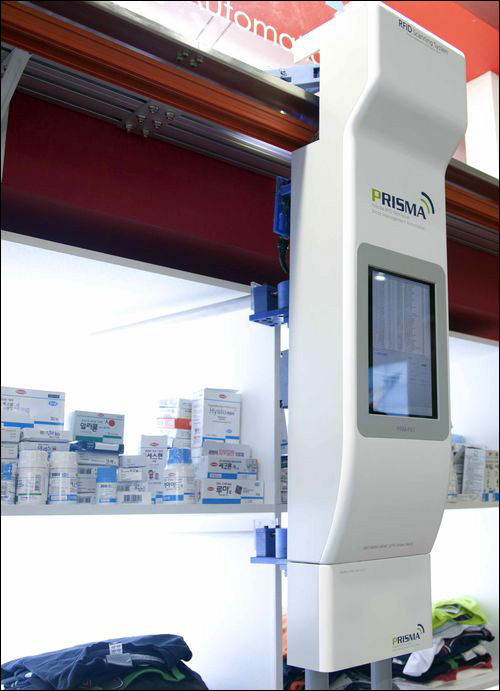Hanmi IT, the IT division of Korea’s largest pharmaceutical company, Hanmi Pharmaceutical, has developed a robotic RFID-based reading system that uses a motorized reader on a track to periodically interrogate tags by sweeping across a length of shelves or racks. The solution, known as PRISMA (Precise RFID Item-level Stock Management Automation), evolved from ultrahigh-frequency (UHF) RFID technology that Hanmi IT developed so that it could track its own pharmaceutical products. The PRISMA solution is intended for use by Hanmi’s customers, such as drugstores, as well as by other types of businesses tracking tagged goods.
The self-propelled PRISMA unit takes the place of a worker equipped with a handheld RFID reader. The device travels along rails installed along shelving, walls or ceilings, reading RFID tags on such items as pharmaceutical supplies placed on shelves. It then forwards that information to a user’s own management system, via Hanmi IT middleware.
In 2010, Hanmi Pharmaceutical launched an RFID tracking system developed by Hanmi IT. The drugmaker began attaching EPC passive UHF tags to the 60 million product units that it manufactures annually, in order to enable the tracking of those goods as they are picked, packed and then shipped from its factories to distribution centers (see Hanmi Pharmaceutical Uses RFID to Automate Picking, Shipping).
During the past two years, Hanmi IT also developed an RFID smart-shelf system that could be used by its customers—pharmacies and hospitals—to track, in real time, the locations and expiration dates of tagged medications on their shelves. The solution required the installation of readers at the shelves, with multiple antennas surrounding each shelf area. “However, the reading result was quite disappointing,” says Jay Jun, Hanmi IT’s strategy and planning manager, “and the amount of time and cost for installation and material was very considerable.” Therefore, Jun’s group began creating a system that could deliver a better reading success rate, and be more efficient to install and operate.
“After hard work during 10 months, we finally devised this device,” Jun states.
PRISMA’s reader and motorized wheels receive their electric power from the rail on which the unit moves. As such, there is no need for additional power cables or batteries for the reader itself. The device comes with a 10-inch touchscreen on the front, to provide read data to staff members onsite. On the PRISMA screen, personnel can view the data-collecting status via a prompt called the “Device Status Window.” Operators can also configure the unit through the “Device Operation” user interface—to change the speed or frequency of reads, for example. The RFID data is interpreted by Hanmi’s Edge middleware, which comes installed on the reader, and is then transmitted either by a Wi-Fi or cellular connection to the user’s own back-end system.
The device has a built-in LS Industrial Systems (LSIS) RFID interrogator made with an Impinj reader chip. While each PRISMA unit has one built-in reader, it can have as many antennas as necessary. The device’s height is extendable up to 30 meters (98.4 feet) if required, by attaching additional antennas to the extended frame in order to enable the reader to interrogate tags on items placed on shelves at a variety of heights during a single pass.
PRISMA’s read range is up to 3 to 5 meters (9.8 to 16.4 feet), Jun says, noting that the system offers the highest performance when tags are located approximately 1 meter (3.3 feet) away. Typically, the device could read up to 2,500 to 3,000 tags per meter traveled, when moving at a speed of 2 to 3 inches per second.
By employing robotic technology, Jun says, the solution utilizes far fewer readers and antennas than a smart-shelf system would require, and eliminates the need for human labor that a manual system (involving handheld readers) would necessitate. By providing regular read events, which would be more frequent than is typically accomplished using a handheld reader, the PRISMA unit offers greater options to an end user, he explains—including the detection of erroneous product placement or lost items, as well as the ability to generate automatic replenishment reports to restock goods when the number of a particular item reaches a specified minimum threshold.
According to Jun, the system would work within an environment containing just a few shelves, such as a pharmacy, or it could be installed within a large warehouse to read individually RFID-tagged items. Although the technology was designed for the pharmaceutical industry, he adds, it has other potential use cases as well. The PRISMA system could be installed, for instance, on a ceiling or rack, to read a wide variety of items within a store, warehouse or manufacturing site. “It doesn’t necessarily need to be shelves,” he states, “but also possibly a line of clothes racks, or open space, such as an open grocery refrigerator or line of open tables.”
The system not only reads RFID tags, but can also scan bar-code labels, as long as there is a clear line of sight between the scanner and the bar code printed on each item.
In addition, Hanmi IT offers another version of the PRISMA unit, in which the reader is pulled along the rail by a cable and an external motorized pulley, similar to how a ski lift operates. The alternate version is not as large as the one with a built-in motor, the company reports, and is intended for small-scale stores.
The technology may be needed in a variety of industries beyond pharmaceuticals, Jun says. “In my opinion, it would be most ideal to a library, which more likely demands location information of each book,” he explains.
The PRISMA system, released commercially last month, has several prospective customers, including a university library, two major Korean apparel wholesale businesses, a drug company and a major logistics firm. What’s more, Hanmi Pharmaceutical plans to use the system at its warehouses, to read tags on goods stored prior to their shipment to customers.



